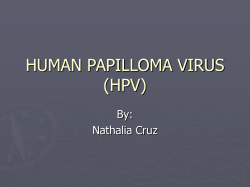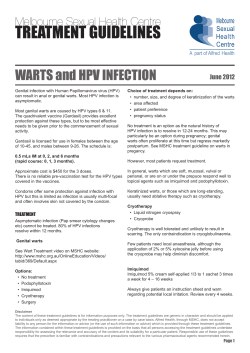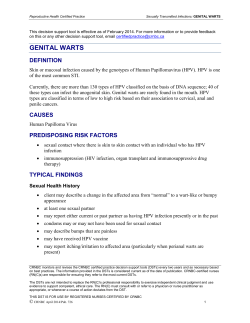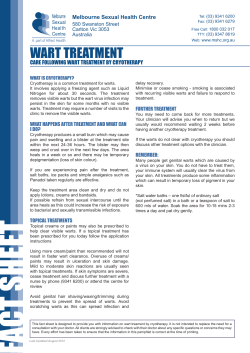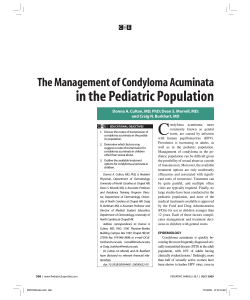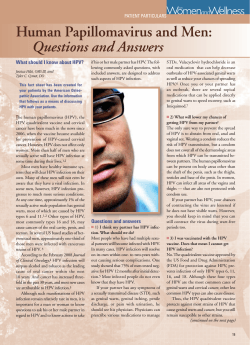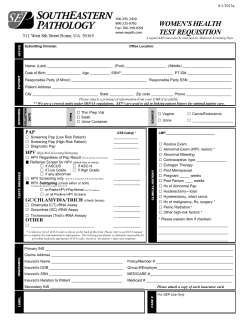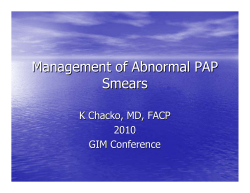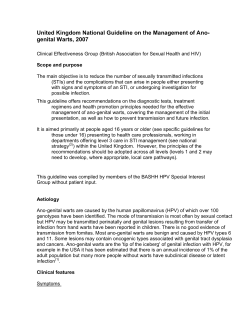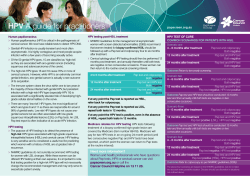
Document 50246
Herpes & HPV Los Angeles County Department of Public Health Sexually Transmitted Disease Program Health Education Unit Today’s Agenda O Information on STDP Health Education Unit services O Participant introductions O Herpes O HPV/Genital Warts O Psychosocial aspects of Herpes and HPV/Genital Warts 2 STDP Health Education Unit Services O Toll free STD Hotline 1-800-758-0880 – STD/HIV Q&A – Referrals to free & low-cost clinics – Free condoms by mail O Educational materials O Audio-visual resources O Condom Donation Program O Community-level presentations & health fairs O Staff/provider training O CME 3 Services Available at LAC STD Clinics O STD screening, evaluation, and treatment O Free Condoms O STD Hotline – 1-800-758-0880 O Emergency Contraception (EC) – Only for STD patients – EC Hotline 1-800-521-5211 4 Introduce Yourself! O Name O Agency/Position O Your Herpes/HPV experience with clients O Something about you we wouldn’t know just by looking at you 5 Workshop Objectives By the end of today’s workshop, you should be able to: O Name the modes of transmission, symptoms, complications, testing and treatment for genital herpes O Name the modes of transmission, symptoms, complications, testing and treatment for HPV O Identify and explain underlying psychosocial issues associated with HSV and HPV O Have some fun! 6 Ground Rules O Please commit to the full training. O Please be on time when returning from break. O Please set cell phones and pagers to silent for the duration of the training. – If you need to take a call, please go out to the hallway and close the doors behind you. 7 Ground Rules, cont’d O Learning comes from mistakes. Everyone will be supported for taking risks. O We acknowledge individual differences among members of this group. We will not agree on everything and that is OK. O Confidentiality guidelines will be adhered to by all participants. 8 Ground Rules, cont’d O You have the right to pass on any activity. O Trainers will maintain structure and keep the group on track. O Parking Lot 9 10 Annual New Cases of STDs (Estimated Incidence in US = 19 million) HPV 6.2 million Trich CT 3 million Herpes 5 million 1.6 million GC 650,000 Hep B 73,000* Syphilis 70,000 HIV 40,000* Hep C 30,000* 0 1 2 3 4 5 6 * Total includes infections as a result of sexual and non-sexual transmission. 11 Herpes and HPV Trends in the U.S. Herpes Simplex Virus Type 2 (HSV2) incidence: 1.6 million new cases each year prevalence: 50 million infected Human Papillomavirus (HPV) incidence: 6.2 million new cases each year prevalence: 20 million infected 12 The Truth About Herpes Simplex 1 (HSV1) and Herpes Simplex 2 (HSV2) 13 Herpes Simplex 2 (HSV2) O MYTH: HSV2 is a painful, dangerous infection that affects only people with very active sex lives. O REALITY – 1 in 5 adult Americans (ages 12 and over) from all backgrounds, income levels and ethnic groups have HSV2 – About 1.6 million new cases occur each year – Like HSV1, type 2 is usually mild, SO mild that 90% of infected people don’t know they have it – HSV2 rarely causes complications or spreads to other parts of the body 14 Herpes Simplex 2 O 50 million Americans are infected O Prevalence is up 30% since the late 1970’s O Peak incidence is in the 20 to 30 year-old age bracket 15 Transmission of HSV2 O Sources – Skin-to-skin or mucous membrane-to-mucous membrane contact – Transmitted with or without recognizable symptoms O Activities – Vaginal sex – Anal sex – Oral sex – Foreplay – Autoinoculation – Perinatal transmission 16 Transmission of HSV2 O Usually causes blisters in the genital area, but can affect any part below the waist O Almost all HSV2 is encountered after childhood when people become sexually active O People who have had a prior infection with HSV1 have a lower chance of getting symptoms with HSV2 O Females are at higher risk of getting HSV2 – Female to male transmission (no condom, no visible symptoms): 4% – Male to female transmission (no condom, no visible symptoms): 17% 17 Transmission of HSV1 O Typically causes fever blisters or cold sores near the mouth – HSV1 can affect any body part above the waist O Oral HSV1 is the most easily acquired herpes infection (social kiss to a child) O 50% of Americans have HSV1 as young adults O By age 50, 80-90% of Americans have HSV1 18 HSV1 and HSV2 Similarities O Under a microscope, HSV1 and HSV2 are virtually identical, sharing approximately 50% of their DNA O Both types: – Infect the body’s mucosal surfaces, usually the mouth or genitals, and then establish latency in the nervous system – Many infected people have no symptoms, or symptoms too mild to notice – Can recur and spread even when no symptoms are present 19 HSV1 and HSV2 Differences O The site where the virus establishes latency in the body is called the “site of preference” O HSV1 usually establishes latency in the trigeminal ganglion, a collection of nerves near the ear O HSV2 usually establishes latency in the sacral ganglion at the base of the spine, and recurs in the genital area O Even these differences are not absolute – either type can reside in either or both parts of the body and infect oral and/or genital areas 20 It’s time to play: 21 Symptoms of Genital Herpes Some places where herpes might occur O Itching or pain in the genital area (and possibly in the buttocks, lower back and thighs) O Blisters in the genital area – They can possibly burst, become raw and then crust over O Possibly headache, fatigue and muscle pain O Less commonly, infections can result in fever 22 Pathway of a Herpes Infection Herpesvirus enters the body Herpesvirus lies dormant in the nerves Herpesvirus is reactivated, causing another outbreak Counseling Guide and Patient Information. GlaxoSmithKline. 2000. 23 Symptoms of Genital Herpes O Typical is not typical – Most individuals do not show classic symptoms – Classic symptoms observed in only 10% of all cases – Atypical nature of herpes makes it harder to diagnose 24 Genital Herpes Spectrum of Presentations 25 Genital Herpes Patient’s Perception of Etiology O Women – Yeast infection – Vaginitis – UTI – Menstrual complaint – Hemorrhoids – Allergies (condoms, sperm, spermicide, pantyhose – Rash from sex, shaving, bike seat O Men – Folliculitis – Jock itch – “Normal” itch – Zipper burns – Hemorrhoids – Allergy to condom – Irritation from tight jeans, sex, bike seat – Insect bite 26 How Many Outbreaks? O Depends on several factors – How well can the person’s immune system control the infection? – How long has the person had the infection? – Has the virus been established in its site of preference? 27 Recurrences O The 1st outbreak – Is the most severe – Some people will never have another one – Others will have frequent recurrences O Symptoms last 7 to 10 days with varying severity O Recurrent outbreaks can occur near site of original blisters O “Prodrome” symptoms include: tingling, itching, burning in genital area, pain in buttocks or legs O These can trigger recurrence: stress, fatigue, illness, menstruation, prolonged exposure to sunlight (oral herpes), physical trauma to the area 28 Asymptomatic Shedding O Transmission can occur even when there are NO SYMPTOMS, up to 20% of the year – Most common time to transmit the virus – 70% of HSV2 transmissions occur when there are no symptoms present in the source partner O Virus reactivates, comes to the surface of the skin, but does not cause visible sores or lesions – People with recurrent HSV1 shed virus in saliva 5% of the time – People with HSV2 shed virus from the genital area about 6-10% of days in their first year of infection O Frequent outbreaks also mean increased time one is shedding 29 Viral Shedding May Occur in the Absence of Lesions + Patterns in Women Viral shedding Lesions Subject 1: HSV-2 seropositive Day 1 Cervix Vulva Perianal Lesion(s) 2 3 4 5 6 7 8 9 10 11 12 13 14 15 16 17 18 19 20 21 22 23 24 25 26 27 28 29 30 31 + + ++ + Subject 2: HSV-2 seropositive Day 1 2 3 4 5 6 7 8 9 10 11 12 13 14 15 16 17 18 19 20 21 22 23 24 25 26 27 28 29 30 31 Cervix Vulva Perianal Lesion(s) + + ++++ Subject 3: HSV-1 seropositive Day 1 2 3 4 5 6 7 8 9 10 11 12 13 14 15 16 17 18 19 20 21 22 23 24 25 26 27 28 29 30 31 Cervix Vulva Perianal Lesion(s) ++++++ ++++++ ++ Subject 4: HSV-2 seropositive Day 1 Cervix Vulva Perianal Lesion(s) 2 3 4 5 6 7 8 9 10 11 12 13 14 15 16 17 18 19 20 21 22 23 24 25 26 27 28 29 30 31 +++++ Wald A et al. N Engl J Med. 1995;333:770-775. 30 Diagnosis O Viral culture – Active herpes sore must be present – Accurate O PCR - DNA Culture Test – No active lesions needed, only symptoms O Antigen detection test – Active herpes sore must be present – Can be done when sores begin to heal – Cannot distinguish between HSV1 and HSV2 O Blood tests – General Antibody Test - some tests may not distinguish between HSV1 and HSV2 – Western Blot –used in research settings only and can distinguish between HSV1 and HSV2 31 HSV Testing – Bottom Line You must ask what kind of test you are getting, and you may not meet the criteria for the test you want in public clinics! 32 Complications O In adults – Usually no long-term complications, but psychosocial effects – Herpes meningitis and herpes encephalitis develop in rare cases – Blisters can become infected O In pregnancy – Miscarriage – Premature labor – Growth retardation 33 Treatment O Anti-viral therapies are standard for genital herpes – Stops virus from replicating, shortens duration of outbreaks, accelerates healing, reduces or prevent outbreaks altogether – Only works when taken as directed! 34 Antiviral Medications O Oral doses – Acyclovir (Zovirax) – Valacyclovir (Valtrex) – Famciclovir (Famvir) O Topical creams and ointments – Cannot cure outbreaks, but can be applied directly to site of an outbreak to relieve symptoms and shorten outbreak duration – Not as effective as oral treatments 35 Natural Treatments O Dietary management – Arginine is an amino acid that the virus needs to replicate – Lysine is a different amino acid – it can suppress the herpes virus 36 Nutritional Tips O Bad to Consume – Sugar – Peanuts – Chocolate – Raisins – Wheat – Rice – Corn / Corn syrup O Good to Consume – Cheese – Vegetables – Vitamins A, B, C, E – Fish – Chicken – Eggs – Beans 37 Risk Reduction O The risk is higher during outbreaks – When sores are present, herpes can spread even without penetration (rubbing against lesions) O Safer sex using a condom or dental dam can reduce likelihood of spreading the disease – Lubricants O Take anti-viral medications as directed O Inform partners of disease status before sexual activity of any kind 38 Risk Reduction When a woman is pregnant O It is rare for genital herpes to be passed on to a baby O Primary outbreaks pose the greatest risk to the baby O The antibodies in the infected mother’s blood may give some immunity to the growing fetus O Outbreaks can be managed by health care provider 39 Advice Health Professionals Can Give O Self-help measures for genital herpes – Avoid sexual contact till episode is over – Keep the area clean and dry, expose the sores to air whenever possible – Wear loose cotton underwear – OTC analgesics can help reduce pain – Moisten the area during urination to reduce pain (i.e., take a warm bath first) 40 Advice Health Professionals Can Give O Self-help measures for genital herpes (cont) – Good nutrition, stress reduction, adequate sleep – Discuss the problem O Psychological effects can be worse than physical symptoms O Offer advice on managing the condition, counseling about relationships, safer sex, pregnancy 41 Additional Information O Vaccine in the works O HIV-HSV connection O LA Help 310-281-7511 – www.lahelp.org 42 Oral Herpes 43 Process of Herpes Outbreak Fluid-filled blisters Open sores Scabbed sores 44 Blisters surrounding vaginal area 45 Healthy Cervix Cervical lesions due to Herpes 46 Herpes blisters on buttocks 47 Lesions due to perinatal herpes infection 48 You Deserve a… Break! 49 Everyone is at risk… 50 Why are We Concerned about Genital HPV? O Because HPV is… – A necessary causative agent in cervical cancer – One of the most common STDs in the US 51 Genital HPV Infection in the US O Very common – 20 million people currently infected – 6.2 new cases annually – Up to 80% of sexually active people will acquire HPV at some point in their lives O Accounts for more than 99% of cervical cancer O Estimated lifetime risk of developing genital warts is about 10% 52 HPV Types O HPV is the name of a group of over 100 viruses – About 70 types are nonsexual in nature and can cause common skin warts – About 30 types occur as a result of sexual contact “High risk” types (16 and 18 most common) – Associated with cervical, anal, vulvar, and penile cancers – Not associated with visible warts “Low risk” types (6 and 11 most common) – Associated with genital warts – Do not cause cancer 53 Transmission O Source of infection is skin-to-skin or mucous membrane to mucous membrane contact, with or without visible symptoms – NOT transmitted by blood or body fluids O Activities – Direct contact with infected areas, usually from vaginal or anal sex – Oral sex possible but rare – Mother to child transmission during birth is very rare 54 What Happens When You Get Infected? O For most people, nothing will happen – The body’s immune system usually eliminates HPV infection O Even if something does happen, HPV can resolve on its own – After high risk HPV is found on the cervix, it becomes undetectable within 2 years in at least 90% of women – Up to 30% of anogenital warts spontaneously regress within four months 55 What Happens When You Get Infected? O Incubation Period: can range from weeks to months to even years later – Hard to determine when or who gave it to you O Symptoms – Low Risk HPV (Genital Warts) Growths or bumps on the vulva, in or around the vagina or anus, on the cervix, penis, scrotum, groin or thigh Rarely cause itching, pain or bleeding Can be flesh-colored, or may cluster together and take the appearance of cauliflower Sometimes the changes are so subtle they cannot be seen by the naked eye 56 What Happens When You Get Infected? O Symptoms (continued) – High Risk HPV “Invisible”/not associated with visible warts May result in abnormal cervical changes 57 HPV Testing O Females – Pap test (indirect) – High-Risk: Digene HC-2 High Risk HPV DNA Test Can be done with pap if over 30 years of age Usually only done in those younger than 30 if abnormal pap result – Low-Risk (warts): Visual exam O Males – High-Risk: No commercial test available – Low-Risk (warts): Visual exam 58 Pap Smears O Screens for pre-cancerous cells in cervix O When to start – 3 years after sexual debut or at age 21, whichever comes first – Remember, you do NOT have to sexually active to get a pap smear O Does not necessarily test for STDs – You have to ask for specific STD tests – It is important to be your own health advocate O How often should I get pap smears? – It varies, depending on your pap results – Your doctor or nurse will let you know 59 HPV Testing – Bottom Line You must ask what kind of test you are getting, and some public clinics may not offer you the kind of test you want! 60 How are Genital Warts Treated? O Goal of treatment is to reduce visible warts O Subclinical cases are rarely treated O None of the current treatments is “better” than the others – Depends on the patient and the symptoms O Factors for selection of treatment – Size of wart(s) – Location if wart(s) – Number of wart(s) – Changes in warts – Patient preference – Cost – Convenience – Adverse effects – Provider experience 61 Common Treatments for Visible Warts O Podofilox gel/liquid is self-applied treatment for external genital warts – Cheap, easy to use and safe O Imiquimod cream is a self-applied treatment for external genital/anal warts – Not harsh on skin, does not cause scarring O Cryotherapy freezes the wart off with liquid nitrogen – Inexpensive, but must be done by a physician or nurse O Podophyllin – Must be applied by a doctor or nurse O Trichloracetic Acid (TCA) – Must be applied by a doctor or nurse 62 Common Treatments for Visible Warts O Laser therapy or surgery uses intense light to destroy warts – Removes warts in one treatment, must be done by highly trained doctor, cost is expensive O 5-fluorouracil cream is self-applied chemotherapy – Best started within 4 wks, causes discomfort, high rate of recurrence O Interferon chemotherapy – There are cheaper therapies with fewer side effects O Cidofovir antiviral gel inhibits cervical dysplasia lesions associated with HPV 63 Cervical High Risk HPV Treatments O If no symptoms (i.e., pre/cancerous lesions), no treatment – Virus disappears on its own O For precancerous or cancerous lesions – Laser therapy – Cold knife or conization procedure (cone biopsy) – Cryotherapy Not recommended for women with HIV – Loop electrosurgical excision procedure (LEEP) Diagnosis and treatment completed in one visit 64 Can HPV Be Cured? O Natural history of HPV – Our body’s immune system usually clears or keeps it under control, and nothing will happen to most people O Genital warts – Treatment is not a cure – It can take several tries to find a treatment that works (every patient is different) – Virus can stay in nearby skin after treatment and be dormant, so it can recur anytime – Some people never have a recurrence About 1/3 clear 65 Natural History of HPV O HPV persistence is associated with: – Age (30 years and older) – Infection with multiple types – Immune suppression – Infection with high risk types 16 and 18 – Smoking 66 Complications O HPV and Pregnancy – Can cause problems during pregnancy and delivery – Due to hormone changes, warts can grow in size and number, bleed and make delivery more difficult – Very rarely, newborns exposed to HPV at birth develop warts in the throat – Despite these risks, a woman does not need a Csection unless warts are blocking the birth canal – It is very important women inform their health care providers if they have HPV or genital warts 67 Complications O Cervical cancer – Second most common cancer among women worldwide – About 9,700 new cases reported annually in the US – About 3,700 US women die each year – Cervical cancer is slow-growing, and is treatable if caught early Underscores the importance of regular pap smears 68 High Risk HPV and Males O Currently no test available to check for high risk HPV in males O If client has female partners – Encourage partners to get regular paps O If client has male partners – Get regular checkups and check self for abnormalities – Complications such as penile, anal and urethral cancers are not as common as cervical cancer, but some studies now showing they are not as rare as once thought Anal paps in research settings at this time 69 HPV Vaccine O Gardasil® by Merck approved in 2006 – Provides protection against four HPV types which together cause 70% of cervical cancers and 90% of genital warts – Licensed for use in girls/women 9-26 years old – Three shots over six-month period 70 HPV Vaccine O Age of vaccination – why chosen? – Preventative only, therefore most effective when given before sexual debut – Higher concentration of the vaccine seen in those less than 14 years of age – 11-12 year olds more likely to access preventative care Provide with other vaccines given at this time 71 Expected Impact of Vaccine O Reduce incidence of abnormal paps O Reduce cost of treatment for abnormal paps O Reduce occurrence of genital warts and cost of treatment O Eventually reduce cervical cancer deaths among unscreened and rarely screened women 72 Unanswered Vaccine Questions O Duration of protection – will booster be needed? O Parental acceptance – Need parental consent for those under 18 years of age O Healthcare provider acceptance O Effectiveness and cost effectiveness in males 73 Availability of Vaccine in LA County O Private insurance/providers O Covered by the federal Vaccines for Children (VFC) program for children/teens up to 19 years of age who are uninsured, Medicaid eligible, or American Indian/Alaska Native O May be covered for women up to age 26 via Medi-Cal O LA County Immunization Program currently compiling a list of clinics offering vaccine O Expensive – $120 per dose, $360 for series 74 Another HPV Vaccine in the Works… O Another vaccine by GSK, “Cevarix”, currently in final stages of development – Not yet FDA-approved – Would provide protection against high risk HPV types 16 and 18 75 Educational Messages O Genital HPV is a very common STD with infrequent significant disease O Routine pap screening is the only way to prevent cervical cancer O For parents: Ask your doctor about the vaccine at your daughter’s next checkup – Even in the best case scenario (child waits until marriage to have sex), she can still get HPV – Wouldn’t you want to protect your child from something as serious as cancer, no matter how they got it? O Bottom line: The best way to prevent HPV is to practice safer sex, get regular paps if you’re female, and get vaccinated if you are under the age of 26 and female 76 (for now) Multiple, fleshy warts on penis Single, flat/round wart on penis 77 Cauliflower-like warts near vagina 78 Enlarged warts due to pregnancy 79 Warts in the anal area 80 Anal warts - Male 81 Stretch Break! 82 83 What Does “Psychosocial” Mean? O “Psycho” refers to your own psychology, how you are as an individual – How do you feel about yourself – What makes you feel good, bad, happy, sad, ashamed, etc… O “Social” refers to how you are in a group, how interacting with others makes you feel – Group interactions – Dealing with another person or groups of people 84 How Do People Feel When They Think or Find Out they Have HSV/HPV? O Emotional distress O Blaming partner(s) O Disrupted relationships O Fear of transmitting disease O Fear of rejection O Loss of confidence O Isolation O O O O O O Confusion Denial Anxiety Fear Depression Alteration of sexual attitudes or behaviors 85 Patient Reactions to Diagnosis O Most patients perceive STDs as a stigmatizing disease – “Only promiscuous people get STDs” – May be in complete shock (“how could this happen to me?”) – May expect lack of respect from health care providers and therefore may not seek care 86 Patient Reactions to Diagnosis O Can have confusion about the disease and what it means for their future – “Will I ever be able to have sex again?” O Partner issues – Questions of fidelity – Decision to disclose 87 Counseling O Primary objective: to help clients make informed decisions O Help clients understand the disease – Assess patient understanding; use terms the patient will understand – Give important messages and written materials at the beginning (client may tune out) – Address patient’s misconceptions about STDs – Stress that STDs are very common – May be encouraging to mention that even sexually responsible people get STDs 88 Counseling O Discuss risk reduction strategies O Address psychosocial issues – Referrals are key (e.g., support groups, diseasespecific resources) O Address partner issues O Be positive and encouraging throughout the session O Acknowledge that all this information may be difficult to absorb 89 Obstacles to Effective Counseling for Providers O Provider stereotypes and biases about STDs and the people who get them O Providers may also feel uncomfortable or awkward in dealing with sexual matters and may lack expertise in conveying information about sexually charged topics O The importance of value free vs. value clear 90 Other Helpful Tips for Clients O Manageable nature of the disease – Emphasize healthy diet, exercise, not smoking, drinking in moderation, getting regular physical exams, practicing safer sex, adequate sleep, stress management – Emphasize virus is treatable and symptoms can be minimized (e.g., warts can be removed/HPV clears over time) O Condoms can help reduce exposure to infected skin, but don’t cover all areas – Lubricants can help reduce friction 91 Other Helpful Tips for Clients O Encourage clients to be active in evaluating their treatment options according to their needs and problems O Long-term management for HPV in women should include regular Pap smears O Encourage use of support groups as a place to discuss physical and psychological aspects of the disease – They are not alone! 92 HSV/HPV Resources & Referrals O ASHA STI Resource Center Hotline (919) 361-8488 www.ashastd.org O LA County STD Hotline (800) 758-0880 www.lapublichealth.org/std O LA Help (Herpes resources, support groups) (310) 281-7511 www.lahelp.org O Centers for Disease Control www.cdc.gov O LA County Immunization Program (213) 351-7800 www.lapublichealth.org/ip 93 Please remember to complete your evaluation. 94
© Copyright 2025
